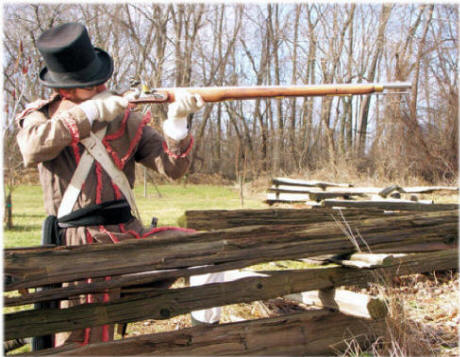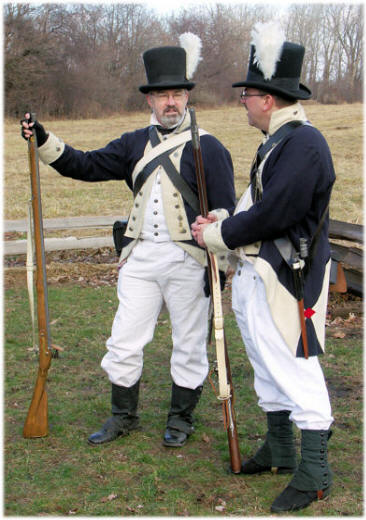Participant
Registration
On Line Store /
Photo Gallery
Introduction
Setting The Stage
The War Of 1812
The Battles
at Frenchtown
Soldiers Fare
Lacroixs
Company
1812 History
Lacroix's Company
Today - Membership
Soldiers Uniforms
Clothing of the Period
Artillery
and Weapons
of the River Raisin Battle
River Raisin Battlefield
Visitors Center
Friends Of the
River Raisin Battlefield
History Links
Area Events
Biographies of Battle
Participants

|
|

United
States Forces at the Raisin
Kentucky troops were often described as destitute, and the
soldiers at the River Raisin were no exception.
By October of 1813, clothing
was already worn out. Tailors were exempted from all other
duties in an effort to keep up with the constant need for
repairs.
“John Richardson wrote that the clothes of the Americans at
the Battle of the River Raisin “…had evidently undergone
every change of season, and were arrived at the last stage
of repair…it was the depth of winter, but scarcely an
individual was in possession of a great coat or cloak, and
few of them wore garments of wool of any description. They
still retained their summer dress, consisting of cotton
stuff of various colors, shaped into frocks, and descending
to the knee; their trousers were of the same material. They
were covered with slouched hats worn bare by constant use,
beneath which their long hair fell matted and uncombed over
their cheeks; and these together with the dirty blankets
wrapped around their loins…and fastened by broad leathern
belts into which were thrust axes and knives of an enormous
length, gave them an air of wildness and savageness...” |

2nd Michigan Territorial Militia Regiment
At the start of the War of 1812, 218 men at the River Raisin
were enrolled in the 7 companies of the 2nd
Michigan Regiment, including 44 in Couture’s company, 34 in
Drouillard’s, 21 in Jobin’s Horse, 27 in LaSalle’s, 21 in
Martin’s, 44 in Menard’s & 27 in Mulholland’s. Most did
garrison and construction duties, but some were involved in
Hull's invasion of Canada, the Battles of Brownstown &
Monguagon, and escorting the mail to Detroit. They served
barely 3 months before becoming prisoners of war released on
parole in August of 1812.

In January of 1813, Lt. Col.
Francois Navarre estimated the militia available at the
River Raisin at 250, scattered from the Huron to the Maumee
and still technically POW’s by the terms of Hull’s surrender
of Detroit in August of 1812. Up to 100 ignored their
parole and fought in the battles of January 18-22.
Those who had the means armed
& clothed themselves according to the 1805 regulations in
blue coats or capotes trimmed white and coming to the knee,
white small clothes, and round hats with white plumes.
Others wore a mix of French-Canadian and Indian garb.

Michigan Legionary Corps
About 100 River Raisin militia enlisted in the
Michigan Legionary Corps. They were the first to
volunteer for duty, helping to build Hull's Road to
Detroit in 1812. Small detachments participated in the
battles around Detroit and were very active in escorting
the mail. Many were in Detroit when General Hull
surrendered his forces in Michigan Territory to the
British & Indians.
Unlike the ordinary militia, the 86 men of
Lacroix’s company were all issued government muskets,
cartridge boxes & bayonets. As they were organized on
the eve of the war and came from the 2nd
Regiment at the River Raisin, it is likely they wore the
2nd Regiment's blue coats trimmed in white rather than
the buff designated for the Legion’s light infantry
company.
Cornet Lee’s small detachment of Smyth’s cavalry was
stationed on the Raisin and wore distinctive red coats
trimmed in black velvet, white vests, buckskin breeches,
boots, and leather caps with bearskin, blue turban, &
white plume. They fled the territory to avoid being
included in Hull's surrender.
The rest of the Legion, (Smyth’s cavalry,
Mack’s artillery, and DeQuindre’s riflemen) were
based in Detroit with the 1st Regiment and
were part of the American army surrendered by General
Hull.
|
|